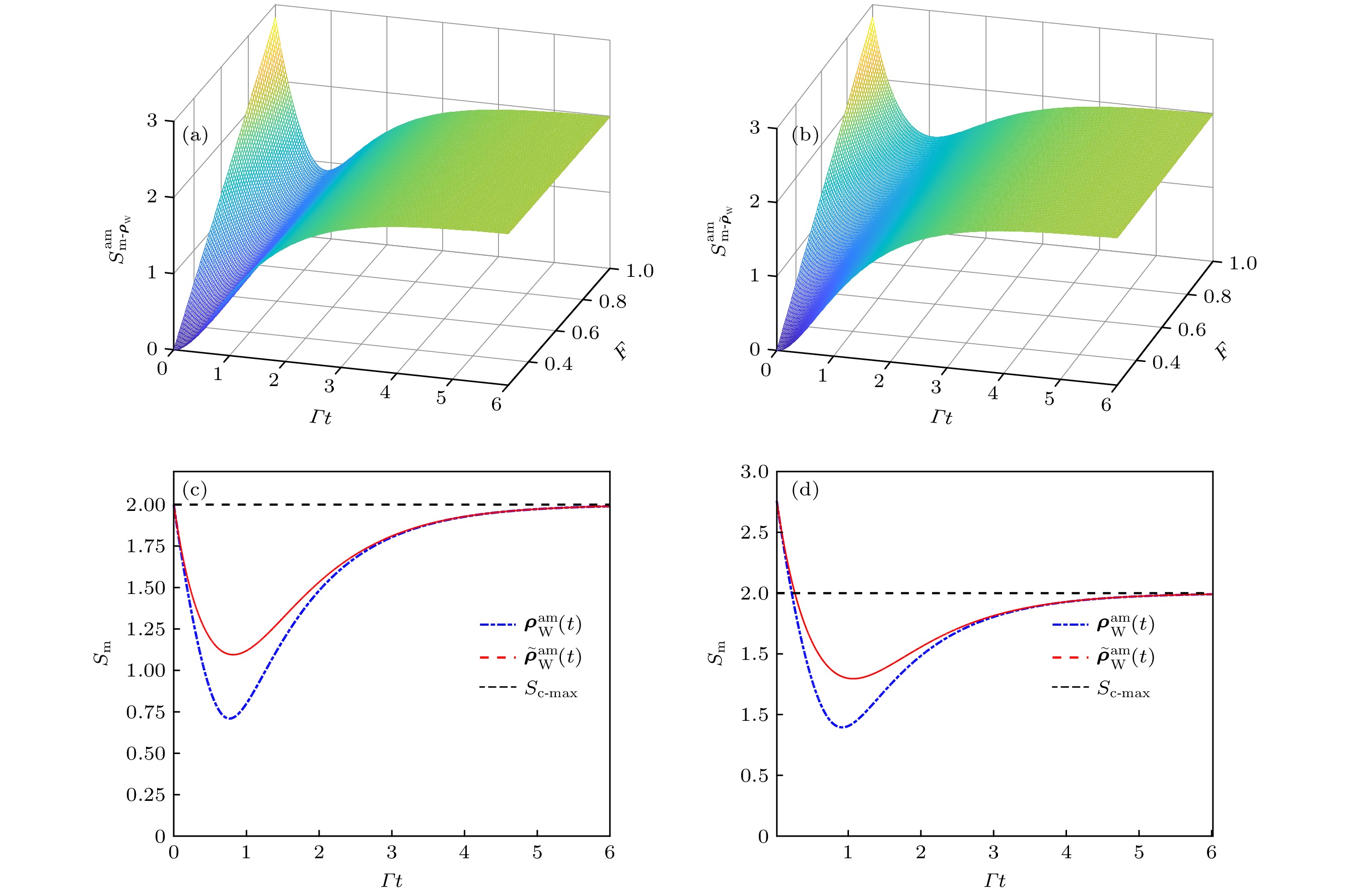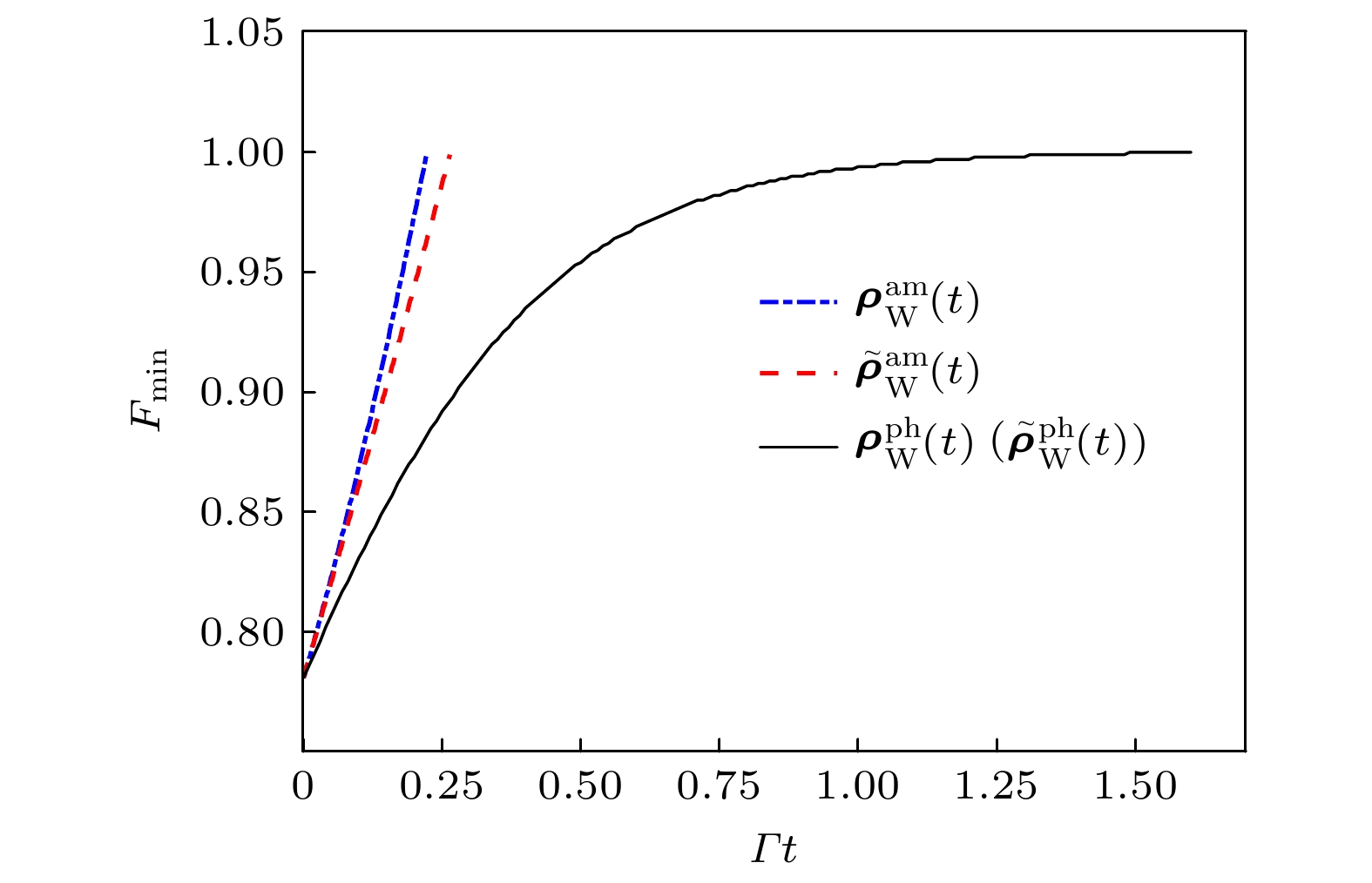-
量子非局域关联是量子理论最基础的特征之一. “X”态作为实验中常见的一种量子态, 因其在演化过程中仍保持“X”形的稳定性, 而被广泛应用于开放量子系统的研究中. 利用Clauser-Horne-Shimony-Holt (CHSH)不等式, 在Markov环境这种典型的开放量子系统下, 研究了两种通过局部变换操作所关联的“X”态在振幅阻尼环境和相位阻尼环境中量子非局域检验结果随时间的演化情况. 研究结果表明, 在相位阻尼环境中, 随着演化时间的增加, 两种“X”态具有相同的CHSH不等式检验结果. 在振幅阻尼环境中, 利用局部变换操作得到的“X”态, 可获得较长的成功进行量子非局域关联检验的演化时间. 最后, 详细给出了两种类型“X”态在相位阻尼环境和振幅阻尼环境中成功进行量子非局域关联检验的保真度范围.Quantum nonlocality is one of the most fundamental characteristics of quantum theory. As a commonly used quantum state generated in experiment, the “X” state is a typical one in the research of open quantum systems, since it remains the stability of the “X” shape during the evolution. Using the Clauser-Horne-Harmony-Holt (CHSH) inequality, the quantum nonlocality testing of two “X” states associated with local transformation operations is studied under the Markov environment. The results show that in the phase damping environment, the two “X” states have the same CHSH inequality testing results with the increase of the evolution time. Moreover, the maximum of quantum nonlocality test of the two “X” states will decrease nonlinearly. When
$0.78 \lt F \lt 1$ , the maximum value${S_m}$ of testing quantum nonlocality will gradually transition from${S_m} \gt 2$ to${S_m} \lt 2$ with the increase of the evolution time of the two “X” states, and the research on the quantum nonlocality test cannot be successfully carried out. In the amplitude damping environment, the “X” state obtained by the local transformation operation has a longer evolution time for successfully testing quantum nonlocality when$F \gt 0.78$ . In particular, when$F = 1$ , the “X” state with the density matrix${\rho _W}$ cannot successfully test the quantum nonlocality after the evolution time$\varGamma t \gt 0.22$ . For the “X” state with density matrix${\tilde \rho _W}$ , the quantum nonlocality testing cannot be performed until the evolution time$\varGamma t \gt 0.26$ . These results show that the local transformation operation of the “X” state is more conducive to the quantum nonlocality testing based on the CHSH inequality. Finally, the fidelity ranges of successfully testing the quantum nonlocality of the two “X” states in phase and amplitude damping environments are given in detail. The results show that on the premise of the successful testing of quantum nonlocality , the two types of “X” states evolving in the phase damping environment have a large range of valid fidelity. Meanwhile, for the same evolution time, the local transformation operation is helpful in improving the fidelity range of quantum nonlocality test in amplitude damping environment for “X” state with density matrix${\rho _W}$ .-
Keywords:
- quantum nonlocality /
- “X” states /
- CHSH inequality /
- phase damping /
- amplitude damping
[1] Einstein A, Podolsky B, Rosen N 1935 Phys. Rev. Lett. 47 777
[2] Horodecki R 2021 arXiv: 2103.07712 v2 [quant-ph]
[3] Kaur E, Horodecki K, Das S 2022 Phys. Rev. Appl. 18 054033
 Google Scholar
Google Scholar
[4] Kahanamoku-Meyer G D, Choi S, Vazirani U V, Yao N Y 2022 Nat. Phys. 18 918
 Google Scholar
Google Scholar
[5] Portmann C, Renner R 2022 Rev. Mod. Phys. 94 025008
 Google Scholar
Google Scholar
[6] Bell J S 1964 Physics 1 195
 Google Scholar
Google Scholar
[7] Clauser J F, Horne M A, Shimony A, Holt R A 1969 Phys. Rev. Lett. 23 880
 Google Scholar
Google Scholar
[8] Shaukat MI 2022 Eur. Phys. J. Plus 137 205
[9] Nielsen M A, Chuang I L 2000 Quantum Computation and Information (Cambridge: Cambridge University Press) pp380–386
[10] Yu T, Eberly J 2007 Quantum Inf. Comput. 7 459
[11] Quesada N, Al-Qasimi A, James D F 2012 J. Mod. Opt. 59 1322
 Google Scholar
Google Scholar
[12] Guo Y N, Wang X, Chen X J 2022 Quantum Inf. Process. 21 149
 Google Scholar
Google Scholar
[13] Kelleher C, Holweck F, Lévay P, Saniga M 2021 Results Phys. 22 103859
 Google Scholar
Google Scholar
[14] Namitha C, Satyanarayana S 2018 J. Phys. B: At. Mol. Opt. Phys. 51 045506
 Google Scholar
Google Scholar
[15] Zhao F, Wang D, Ye L 2022 Int. J. Theor. Phys. 61 1
 Google Scholar
Google Scholar
[16] 曾柏云, 辜鹏宇, 胡强, 贾欣燕, 樊代和 2022 物理学报 71 170302
 Google Scholar
Google Scholar
Zeng B Y, Gu P Y, Hu Q, Jia X Y, Fan D H 2022 Acta Phys. Sin. 71 170302
 Google Scholar
Google Scholar
[17] 胡强, 曾柏云, 辜鹏宇, 贾欣燕, 樊代和 2022 物理学报 71 070301
 Google Scholar
Google Scholar
Hu Q, Zeng B Y, Gu P Y, Jia X Y, Fan D H 2022 Acta Phys. Sin. 71 070301
 Google Scholar
Google Scholar
[18] Zhang Y S, Huang Y F, Li C F, Guo G C 2002 Phys. Rev. A 66 062315
 Google Scholar
Google Scholar
[19] Seiler J, Strohm T, Schleich W P 2021 Phys. Rev. A 104 032218
 Google Scholar
Google Scholar
[20] Yu T, Eberly J 2004 Phys. Rev. Lett. 93 140404
 Google Scholar
Google Scholar
[21] Li W, He Z, Wang Q 2017 Int. J. Theor. Phys. 56 2813
 Google Scholar
Google Scholar
[22] Mishra S, Thapliyal K, Pathak A 2022 Quantum Inf. Process. 21 70
 Google Scholar
Google Scholar
-
图 2 相位阻尼环境中,
$S_{{\text{m}} \text- {{\boldsymbol{\rho}} _W}}^{{\text{ph}}}$ 和$S_{{\text{m}} \text- {{\tilde {\boldsymbol{\rho}} }_W}}^{{\text{ph}}}$ 随演化时间$\varGamma t$ 和保真度F的变化关系图Fig. 2.
$S_{{\text{m}} \text- {{\boldsymbol{\rho}} _W}}^{{\text{ph}}}$ and$S_{{\text{m}} \text- {{\tilde {\boldsymbol{\rho}} }_W}}^{{\text{ph}}}$ versus evolution time$\varGamma t$ and fidelity F in a phase damping environment.图 3 振幅阻尼环境中,
$S_{{\text{m}} \text- {{\boldsymbol{\rho}} _W}}^{{\text{am}}}$ ($S_{{\text{m}} \text- {{\tilde {\boldsymbol{\rho}} }_{\text{W}}}}^{{\text{am}}}$ )随保真度F和演化时间$ \varGamma t $ 的变化关系图 (a), (b) 保真度在$ 0.25 \leqslant F \leqslant 1 $ 变化时的情况; (c), (d)$ F = 0.78 $ 和$ F = 1.00 $ 时的情况Fig. 3.
$S_{{\text{m}} \text- {{\boldsymbol{\rho}} _W}}^{{\text{am}}}$ ($S_{{\text{m}} \text- {{\tilde {\boldsymbol{\rho}} }_W}}^{{\text{am}}}$ ) versus evolution time$ \varGamma t $ in amplitude damping environment: (a), (b) The situation when the fidelity changes in$ 0.25 \leqslant F \leqslant 1 $ respectively; (c), (d) the situation when$ F = 0.78 $ and$ F = 1.00 $ respectively.图 4
${F_{\min }}$ 与时间$\varGamma t$ 的变化关系图. 其中蓝色点划线表示密度矩阵为${{\boldsymbol{\rho}} _W}$ 的“X”态在振幅阻尼信道下的演化曲线; 红色虚线表示密度矩阵为${\tilde {\boldsymbol{\rho}} _W}$ 的“X”态在振幅阻尼信道下的演化曲线; 黑色实线表示两“X”态在相位阻尼信道下的演化曲线Fig. 4.
${F_{\min }}$ versus time$\varGamma t$ . The blue dotted line represents the evolution curve of the “X” state with the density matrix${{\boldsymbol{\rho}} _{\rm{W}}}$ under the amplitude damping channel; the red dotted line represents the evolution curve of the “X” state with density matrix${\tilde{\boldsymbol{\rho}} _{\rm{W}}}$ under the amplitude damping channel; the black solid line represents the evolution curve of two “X” states in a phase damped channel. -
[1] Einstein A, Podolsky B, Rosen N 1935 Phys. Rev. Lett. 47 777
[2] Horodecki R 2021 arXiv: 2103.07712 v2 [quant-ph]
[3] Kaur E, Horodecki K, Das S 2022 Phys. Rev. Appl. 18 054033
 Google Scholar
Google Scholar
[4] Kahanamoku-Meyer G D, Choi S, Vazirani U V, Yao N Y 2022 Nat. Phys. 18 918
 Google Scholar
Google Scholar
[5] Portmann C, Renner R 2022 Rev. Mod. Phys. 94 025008
 Google Scholar
Google Scholar
[6] Bell J S 1964 Physics 1 195
 Google Scholar
Google Scholar
[7] Clauser J F, Horne M A, Shimony A, Holt R A 1969 Phys. Rev. Lett. 23 880
 Google Scholar
Google Scholar
[8] Shaukat MI 2022 Eur. Phys. J. Plus 137 205
[9] Nielsen M A, Chuang I L 2000 Quantum Computation and Information (Cambridge: Cambridge University Press) pp380–386
[10] Yu T, Eberly J 2007 Quantum Inf. Comput. 7 459
[11] Quesada N, Al-Qasimi A, James D F 2012 J. Mod. Opt. 59 1322
 Google Scholar
Google Scholar
[12] Guo Y N, Wang X, Chen X J 2022 Quantum Inf. Process. 21 149
 Google Scholar
Google Scholar
[13] Kelleher C, Holweck F, Lévay P, Saniga M 2021 Results Phys. 22 103859
 Google Scholar
Google Scholar
[14] Namitha C, Satyanarayana S 2018 J. Phys. B: At. Mol. Opt. Phys. 51 045506
 Google Scholar
Google Scholar
[15] Zhao F, Wang D, Ye L 2022 Int. J. Theor. Phys. 61 1
 Google Scholar
Google Scholar
[16] 曾柏云, 辜鹏宇, 胡强, 贾欣燕, 樊代和 2022 物理学报 71 170302
 Google Scholar
Google Scholar
Zeng B Y, Gu P Y, Hu Q, Jia X Y, Fan D H 2022 Acta Phys. Sin. 71 170302
 Google Scholar
Google Scholar
[17] 胡强, 曾柏云, 辜鹏宇, 贾欣燕, 樊代和 2022 物理学报 71 070301
 Google Scholar
Google Scholar
Hu Q, Zeng B Y, Gu P Y, Jia X Y, Fan D H 2022 Acta Phys. Sin. 71 070301
 Google Scholar
Google Scholar
[18] Zhang Y S, Huang Y F, Li C F, Guo G C 2002 Phys. Rev. A 66 062315
 Google Scholar
Google Scholar
[19] Seiler J, Strohm T, Schleich W P 2021 Phys. Rev. A 104 032218
 Google Scholar
Google Scholar
[20] Yu T, Eberly J 2004 Phys. Rev. Lett. 93 140404
 Google Scholar
Google Scholar
[21] Li W, He Z, Wang Q 2017 Int. J. Theor. Phys. 56 2813
 Google Scholar
Google Scholar
[22] Mishra S, Thapliyal K, Pathak A 2022 Quantum Inf. Process. 21 70
 Google Scholar
Google Scholar
计量
- 文章访问数: 6272
- PDF下载量: 79
- 被引次数: 0
























 下载:
下载:





























